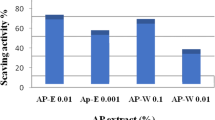Abstract
In the present study, a novel eco-friendly production of silk fabrics dyed with different natural dye bath concentrations (40, 80, 120, 160, 200 and 240 g/l) extracted from neem (Azadirachta indica) leaves was developed. The surface morphology of the fabrics was examined by scanning electron microscopy (SEM) and Fourier-transform infrared (FTIR) spectroscopy to characterize the chemical structure of the fabrics. The SEM images of the undyed fabric show that the fabric was tightly woven with little porosity between the fibres with dozens of silk threads in orthogonal directions. By increasing the neem concentration, a scale of fine particles grew on the surface of the silk fabrics with little macroscopical defects was demonstrated. The fiber diameters and tightness between filaments were significantly increased. The FTIR displayed that, neem dye does not change the characteristic peaks of the silk fabrics. Also, the evaluation of the antimicrobial activity of the undyed and neem dyed silk fabrics was monitored for Gram positive and Gram negative bacteria in addition to yeasts and fungi by using the agar diffusion method. The comparison between the different dye bath concentrations was based on the inhibition zones obtained after incubation. The antimicrobial activity in leaf extract of neem was estimated in Staphylococcus aureus, Bacillus subtilis and Lactobacillus cereus (Gram positive bacteria); Escherichia coli (Gram negative bacteria); Candida albicans and Candida tropicalis (yeasts); and Aspergillus niger and Fusarium solani (fungi). The results emphasized that, the highest neem dye bath concentration (240 g/l) was found to display good inhibitory effect against the Gram positive and reasonable activity against the Gram negative bacteria. Furthermore, the different dye bath concentrations possess no activities against yeast and fungi. In conclusion, the data reveal that the increase of neem dye concentration does not damage the silk fabric; however, it improves its antimicrobial activity by incorporating with antimicrobial agent. The current study highlighted that using neem leaves had beneficial effect in controlling the pathogenic microbial organisms.
Similar content being viewed by others
References
I. Dumitrescu, P. S. Vankar, J. Srivastava, A. M. Mocioiu, and O. Iordache, Industria Textila, 63, 327 (2012).
D. S. Morais, R. M. Guedes, and M. A. Lopes, Materials, 9, 498 (2016).
O. Iordache, A. Cozea, E. Varzaru, E. Stoica, C. Platon, S. Rodino, and I. Dumitrescu, Scientific Bulletin, Series F. Biotechnologies, XX, 362 (2016).
A. Pal, R. Kumar and Y. C. Tripathi, Int. J. Pharm. Pharm. Sci., 8, 387 (2016).
G. Nieto, Medicines, 4, 63 (2017).
M. Kumaresan, P. N. Palanisamy, and P. E. Kumar, Univ. J. Environ. Res. Technol., 2, 280 (2012).
M. Yusuf, M. Shabbir, and F. Mohammad, Nat. Prod. Bioprospect., 7, 123 (2017).
M. A. Alzohairy, Evidence-Based Complementary and Alternative Medicine, 2016, Article ID 7382506 (2016).
U. Francine, U. Jeannette, and R. J. Pierre, J. Med. Plants Studies, 3, 85 (2015).
N. Wali, S. Dhavan, S. Garg, and S. N. Upadhyay, “Antiinflammatory Effect of Neem Leaf Extract”, Proceedings of World Neem Conference, Bangalore, India, 1993.
A. M. Mujumdar, A. S. Upadhye, and A. M. Pradhan, Ind. J. Pharm. Sci., 60, 363 (1998).
R. R. Raut, A. R. Sawant, and B. B. Jamge, J. Acad. Ind. Res., 3, 327 (2014).
K. G. Bhattacharyya and A. Sarma, Dyes Pigm., 57, 211 (2003).
Z. S. S. Al-Hashem and M. A. Hossain, Pacific Sci. Rev. A: Nat. Sci. Eng., 18, 128 (2016).
P. Ajaybhan, Navneet, and A. Chauhan, Report and Opinion, 2, 37 (2010).
M. S. Khehra, H. S. Saini, D. K. Sharma, B. S. Chadha, and S. C. Chimni, Dyes Pigm., 70, 1 (2006).
A. N. Shehata and A. A. Abd El Aty, J. Chem. Pharm. Res., 7, 727 (2015).
A. S. Abd El-All, S. A. Osman, H. M. F. Roaiah, M. M. Abdalla, A. A. Abd El Aty, and W. H. Abd El-Hady, Med. Chem. Res., 24, 4093 (2015).
F. H. El-Batal, A. A. El-Kheshen, G. T. El-Bassyouni, and A. A. Abd El Aty, Silicon, 10, 943 (2018).
K. Yang, R. O. Ritchie, Y. Gu, S. J. Wu, and J. Guan, Mater. Des., 108, 470 (2016).
T.-S. Kim, J.-R. Cha, and M.-S. Gong, Macromol. Res., 25, 856 (2017).
Y. Pan, X. Yang, M. Xu, and G. Sun, Mater. Lett., 191, 10 (2017).
J. Cao and C. Wang, Org. Electron., 55, 26 (2018).
R. Saraswathi, P. N. Krishnan, and C. Dilip, Asian Pac. J. Trop. Med., 3, 128 (2010).
H. J. Kim and I. C. Um, Int. J. Biol. Macromol., 67, 387 (2014).
M. Boulet-Audet, F. Vollrath, and C. Holland, J. Exper. Biol., 218, 3138 (2015).
J. H. Lee, Y. S. Bae, S. J. Kim, D. W. Song, Y. H. Park, D. G. Bae, J. H. Choi, and I. C. Um, Int. J. Biol. Macromol., 106, 39 (2018).
Y. Kawahara, T. Hananoushi, and T. Kimura, Text. Res. J., 73, 289 (2003).
M. Tsukada, M. R. Khan, T. Tanaka, and H. Morikawa, Text. Res. J., 81, 1541 (2011).
J. Shao, J. Zheng, J. Liu, and C. M. Carr, J. Appl. Polym. Sci., 96, 1999 (2005).
A. Bohora, V. Hegde, and S. Kokate, Endodontology, 22, 8 (2010).
R. E. Hafiza, Lancet, 349, 418 (2000).
K. Subramani, V. Murugan, B. K. Shanmugam, S. Rangaraj, M. Palanisamy, R. Venkatachalam, and V. Suresh, J. Alloys Comp., 723, 698 (2017).
M. H. Patel and P. B. Desai, Res. J. Recent Sci., 3, 24 (2014).
Author information
Authors and Affiliations
Corresponding author
Rights and permissions
About this article
Cite this article
Abd El Aty, A.A., El-Bassyouni, G.T., Abdel-Zaher, N.A. et al. Experimental Study on Antimicrobial Activity of Silk Fabric Treated with Natural Dye Extract from Neem (Azadirachta indica) Leaves. Fibers Polym 19, 1880–1886 (2018). https://doi.org/10.1007/s12221-018-8239-3
Received:
Revised:
Accepted:
Published:
Issue Date:
DOI: https://doi.org/10.1007/s12221-018-8239-3



